
Original Link: https://www.anandtech.com/show/2581
FSP Epsilon 80Plus 600W
by Christoph Katzer on August 5, 2008 8:00 PM EST- Posted in
- Cases/Cooling/PSUs
Introduction
Many casual computer users might not be familiar with the name FSP Group (aka Fotron Source), but their power supplies are found in many PC systems from major system integrators. They come to you with bearing other names such as Zalman, OCZ, or be quiet!, but the actual products are produced by FSP. FSP is one of the largest manufacturers of power supplies in the world. I have been to their Taiwanese headquarters several times when I was living in Taiwan back in 2002. The large complex in Tao Yuan is a little outside of Taipei and houses research equipment most techies can only dream of using. The equipment includes an anechoic room and a setup to test electromagnetic interferences.
FSP sent us several of their units that we will be reviewing shortly, beginning today with the Epsilon 600W 80Plus power supply. FSP Group sells power supplies to many of the familiar names in the PSU market, and they also sell them direct under their own two brand names: FSP and Amacrox. We have already reviewed two Amacrox power supplies, but now we'll be looking at a couple FSPs models. The FSP products come with a blue exterior to separate them from other companies. As one of the largest quality PSU manufacturers, one can expect to find only the best components in their own products.

This power supply design first became famous about two years ago, when FSP partnered with a large number of companies and released numerous slightly tweaked models all based off the same basic topology. Today FSP's market share has decreased, with other ODM competitors like Channel Well Technology (CWT) getting the design wins. We hope that FSP is working on some newer models, as competition is always welcome. be quiet! released a very nice FSP-built model last year that delivered efficiency of up to 88%, a design we haven't seen elsewhere, so they certainly have the capacity to produce some very good PSUs. We saw the same topology at the CES booth earlier this year, but it wasn't at their CeBIT booth. We can only guess what happened to that design - perhaps it was simply too expensive to be practical - but it never really made it to the mass production stage.

The Epsilon comes with four 18A 12V rails, which is a good start. The 3.3V rail delivers up to 36A and the 5V rail 30A. The combined power for both the smaller rails shows is 155W, while the combined power for the 12V rails remains unknown since FSP shows 575W together with the maximum of 155W for the both smaller rails. We could hazard a guess of 420W, but that's more of a worst-case scenario. Worth noting is that the Epsilon 80Plus 600W is not the same as the Epsilon FX600-GLN, which many mistakenly assume. The 80Plus certification immediately indicates that this version is a more energy efficiency revision, although it seems to only be available in Europe right now.
Package and Appearance

FSP delivers a unique package and it is unlikely users will ever be able to put it all back together. FSP uses an inset of folded cardboard to secure the power supply and store all of the additional cables, manual, and so on. One nice feature is the small window on the front that lets users see the power supply, though trying to determine quality by looking through the window would be a lot like judging books by their cover art.

As mentioned, the power supply comes with a blue exterior, like all FSP brand PSUs. There is also a power cord, manual, screws, and a sticker in the box. The 120mm fan is guarded by a golden grille wearing a large FSP logo in the center. The back is perforated with hexagonal shaped openings, and next to the power input is a power button that glows blue when in operation. Another typical FSP feature is the flat thin openings on the sides that serve as air intakes when the fan is spinning. FSP uses a kind of stack effect here that sucks the air inside and cools the components directly located behind these openings.

Cables and Connectors

All of the cable harnesses are sleeved with black mesh. FSP uses a different color marking on the 12V cables, which is good when you're trying to determine what goes where. They have yellow cables with green, blue, or orange marking to differentiate the 12V rails. This not only makes the life of a reviewer easier, but it also helps end users who will be able to select connectors to balance the load on the rails. Unfortunately, compared to competing PSUs the Epsilon 600W doesn't have as many connectors.
The choice of graphics cards is limited by the two PCI Express connectors with 6-pins and 6/8-pins. You can still run a moderate SLI/CrossFire setup, but you are limited to cards that only need one 6-pin connector. Alternately, you can run a larger card with two 6-pin or 6-pin and 8-pin connectors. Beside the PEG connections, the Epsilon 600 has each six Molex and SATA connectors on a total of four harnesses, with one harness that also carries the single Floppy connector.
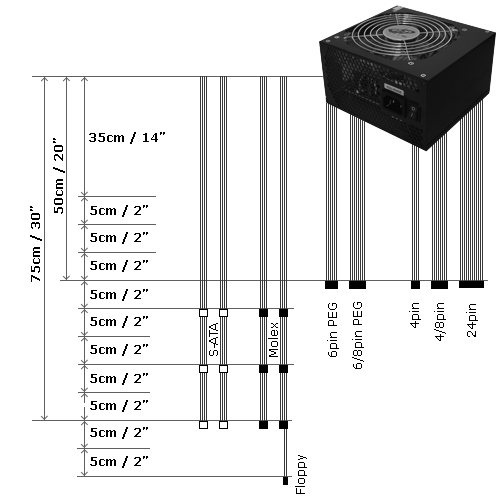
The Fan

The 120mm ball-bearing fan made by Yate Loon seems to be a good choice in regards to noise. Many users buy fans from Yate Loon for their systems to reduce noise levels, and they are well respected. This fan carries the part number D12BH-12.
Internals

Inside we find a three heatsink design. Some designs from Seasonic also use three heatsinks, two on the primary part and the other on the secondary side. We see the same approach with FSP's Epsilon 600. The secondary heatsink is a little larger in volume than the others since it needs to dissipate more heat from the hotter components attached to it.
The heatsink on the far right makes it very difficult to see the components behind it, but the main cap is made by CapXon and rated at 420µF and 420V. The second heatsink for the primary part has two rectifier bridges attached to it on the upper section. It's also easy to spot the secondary capacitors and their respective manufacturers. FSP uses two different suppliers, a few from Teapo and some from CapXon, both of which we have seen many times lately. Since the basic design is several years old now, we didn't expect to find anything extraordinary within the design. However, this design is still sold today and you can expect good quality from PSUs that use it.
Testing with the Chroma ATE Programmable Load
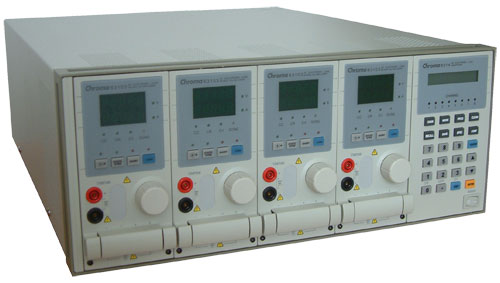
Our test equipment consists of two Chroma programmable DC Loads that enable us to test power supplies with an output of up to 1500W. The biggest advantage of the Chroma DC Loads is simply the high precision it provides. It can measure differences as small as 0.001V and 0.0001A, which will provide us with best-in-class results.
When programming the Chroma with specific amounts of load calculated according to the ATX norm, we are able to load power supplies to an exact percentage. We can now show results at every specific percentage needed. To get the best overview of a power supply, we load each unit with 10%, 20%, 50%, 80%, 100%, and 110% of the specified output. This is easy to calculate for a 1000W power supply: the 10% load is 100W and 110% load is 1100W. Remember that this is the amount of power the PSU delivers; due to inefficiencies, a power supply will actually draw more power from the wall.
Note: If you would like to know more about our testing methodology, equipment, and environment, please read our PSU testing overview.
We have added an additional 10% on the highest load to see how the units perform with overload. This test will be performed in all future reviews. The overload test is performed at room temperature as well as under more stressful conditions; to ensure we are not too cruel to the power supplies, we will keep the ambient temperature at 50°C in the stress test. Experience shows that many units can stand the overload at room temperature but will experience problems with higher temperature and overload together. Only the best-built units will survive this.
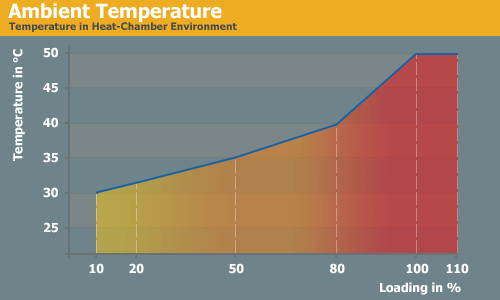
The Testing Environment
There is one flaw in testing power supplies with programmable loads while trying to measure the sound pressure levels at the same time. Because the programmable loads get very loud, there is no chance of hearing the power supply on the test stand. In order to make accurate measurements of the noise levels we needed a way to separate the test unit and the programmable loads. Our solution was to build a very thick box around the unit.
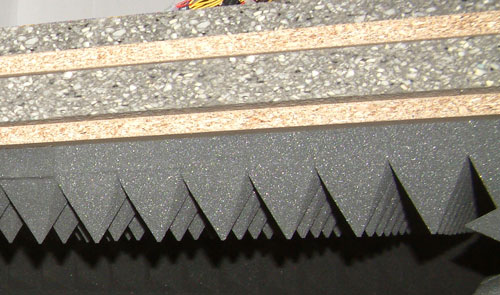
We concluded that a five-layer box with a total thickness of 6" (15cm) containing two layers of wood and three layers of special foam would suffice. It is designed as a box within a box. The inner box does not touch any part of the outer box, making it difficult for acoustic noise to pass through in the form of vibration. Each box is isolated on both sides with a layer of heavy foam that is normally used to insulate engines. On the inside we have an additional layer of 4" (10cm) thick pyramidal foam on every side of the box to eliminate the acoustic waves coming from the test object as well as we can.
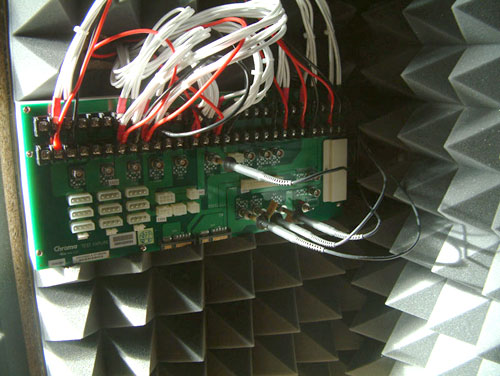
To ensure a completely closed system we installed the printed circuit board that the connectors of the power supply are attached to inside the anechoic room/box. In other box designs, you would need to put all the cables through the wall. Unfortunately, that would result in the inside of the box not being fully isolated anymore. Our design keeps everything that needs to be connected inside of the box and maintains isolation.
DC Output Stability and Quality
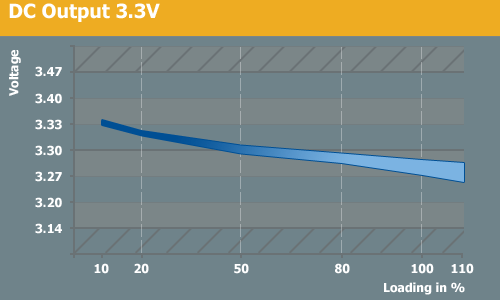
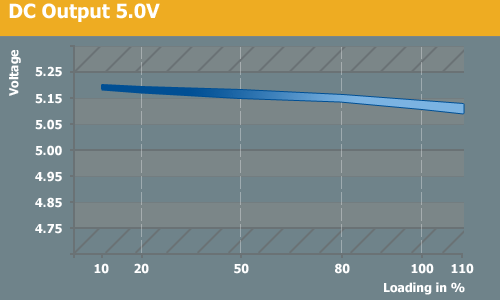
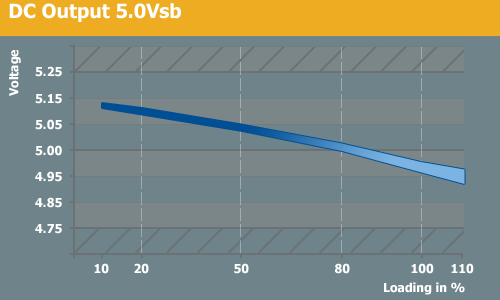
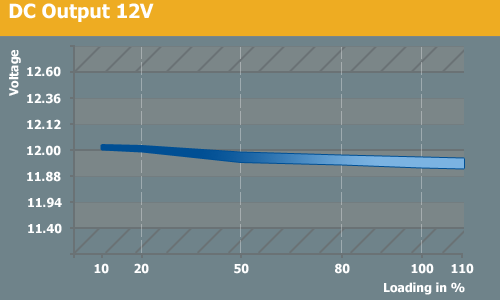
The voltage stability is close to amazing with this unit - unfortunately something we don't always see. The 3.3V rail had the largest regulation with a little more than 2% from the important rails. The 5V rails stayed above 5.00V throughout our load testing. All four 12V rails stayed well within specs, with only 0.6% regulation - perhaps the best we have seen so far. All of the different voltages delivered low ripple and noise results, staying well within specs.
Efficiency
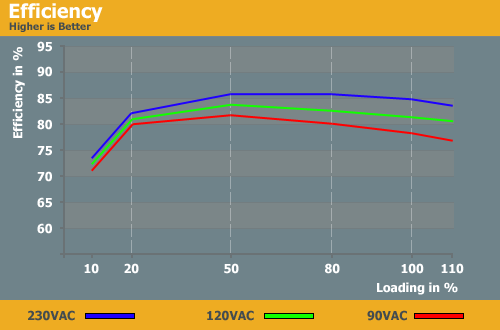
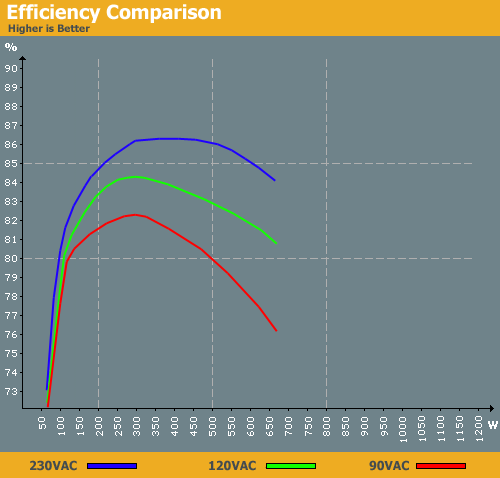
Given the very good voltage regulation, we were very keen on seeing how efficient this power supply is. With a 600W output rating, we also expect to see good efficiency at lower power loads, potentially making this an ideal power supply for entry-level to midrange computers. Starting at around 100W, we already break the 80% efficiency mark and we remain above 80% throughout testing. As you can see in the charts, we also achieved 80% or higher efficiency regardless of input voltage -- though as always, 90 VAC and 115 VAC are slightly lower than 230 VAC, and 90 VAC does drop below 80% at higher loads.
The Epsilon 80Plus 600W is certified as an 80Plus Bronze power supply, and our efficiency results confirmed that rating. Bronze certification requires 82%/85%/82% at loads of 20%/50%/100% (120W/300W/600W); we achieve that (barely) on 230 VAC. Optimal performance is achieved over the range of 200W to 600W, with a maximum efficiency of 87%. While we have seen slightly higher results on some power supplies, getting the last 2% efficiency generally cost quite a bit more money.
Power Factor Correction
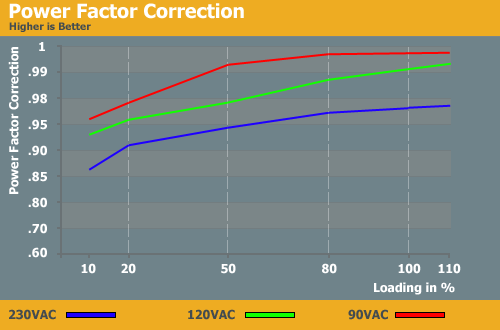
The power factor correction isn't particularly good, but since it is active PFC the results are still ok. However, we have definitely seen better results from many other units.
Fan Speed and Acoustic Noise
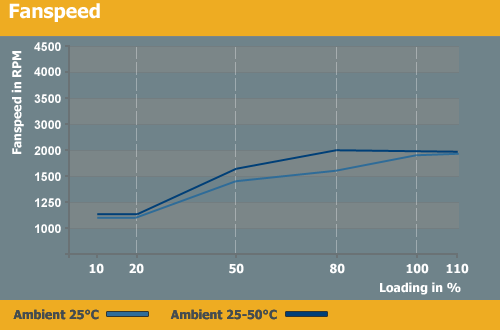
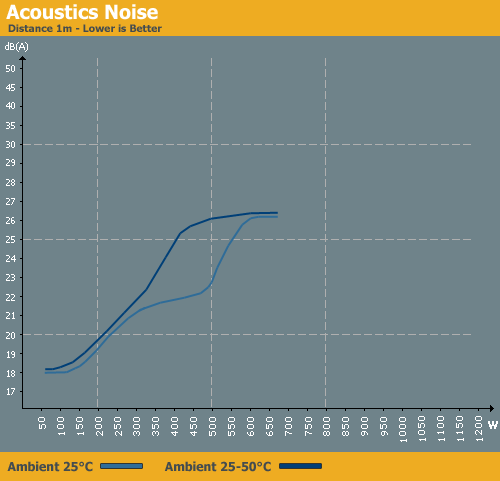
Fan speed starts at just over 1100 RPM; that's not the slowest family scene, but it only generates 18dB(A) of noise. Should FSP desire, they could reduce fan speed even more at lower loads, but given that it's virtually silent already there's no need. Fan speed -- and noise -- does begin to increase quite early, starting at only 20% load. We reached the maximum fan speed of 2000 RPM and 27dB(A) at around 80% load (480W). There is a relatively long period in the middle (50% to 80% load) where fan speed remains relatively constant.
We have seen quite a few similar models to this power supply from other companies, most of them with slightly better acoustic results. However, the corollary to that is that the Epsilon 600W does tend to have lower temperatures. Like several other companies, FSP Group looks to be somewhat more interested in PSU health and longevity than in minimum noise levels. Overall, the maximum noise level of 27dB(A) isn't stellar, but neither is it terrible. If you're looking to put together a silent computer, you'll probably want to use some other PSU, but for most systems the graphics card and CPU fan will generate far more noise than this power supply.
Conclusion
As expected, the build quality of this unit is excellent. There is literally nothing to complain about. The Epsilon 80Plus 600W is a good power supply, but there's very little in the way of marketing. Unfortunately, that's typical of larger companies like FSP Group. Smaller companies like Corsair, OCZ, and be quiet! provide similar quality but have huge marketing departments. They tend to know much more about the specific markets than the actual manufacturers.
We see this lack of market knowledge when we look at the connectors of this unit. It comes with 24-pin, 4-pin ATX12V, and 4/8-pin EPS12V connectors, which is fine for the rated output. Six Molex and six SATA connectors are the minimum we would expect, and for a 600W power supply it might even be enough. The two PEG connectors are the bigger concern, as that would make this power supply under-equipped for anyone looking to run two 9800 GTX cards in SLI, or two HD 4870 cards in CrossFire. Then again, SLI/CrossFire certification for the higher-end GPUs requires a higher rating anyway. As it stands, this power supply will be fine for single graphics cards configurations, including cards like the 3870X2 and 9800GX2, or dual-cards like the 8800 GT and HD 4850 that only require a single PEG connector.
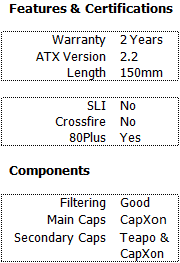 |
As for the internals, we can't really blame FSP for not mixing things up, since the design is a few years old and has sold very well. It still delivers good results and can compete with the competition. The voltage regulation was great and stayed tight throughout the tests. Efficiency is also good with input voltages of 115VAC or more, though the 90VAC results are nothing special. The maximum 87% efficiency at 350W is a very competitive result.
The fan starts at a somewhat high speed of 1100RPM, but this still results in a good sound reading of just 18dB(A). Unfortunately, this scales to the maximum 27dB(A), and particularly in higher temperature environments it will hit that point at relatively low loads. That's still good compared with some other power supplies, but a 600W PSU can run at much lower noise levels as we have seen before. For a price of around 100€, users in Europe can purchase a well built unit which should run quite well. There are competitors that offer a similar feature set, quality, and performance, but frequently prices are higher. If you don't need anything more than a 600W PSU, this FSP is worth a look. If you're going to purchase an FSP-built PSU, you might as well go straight to the source.



















